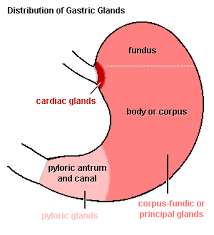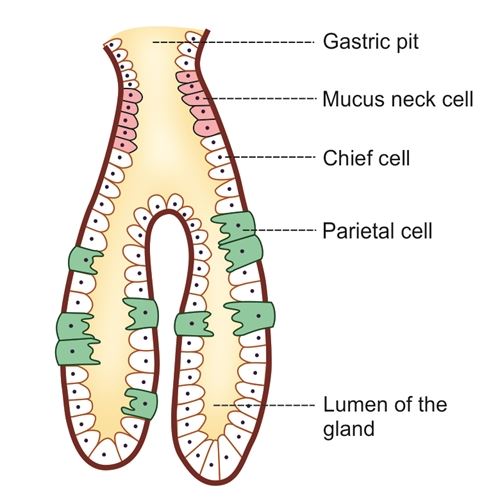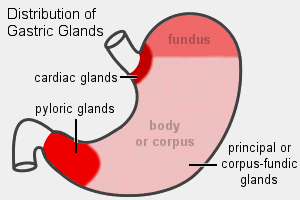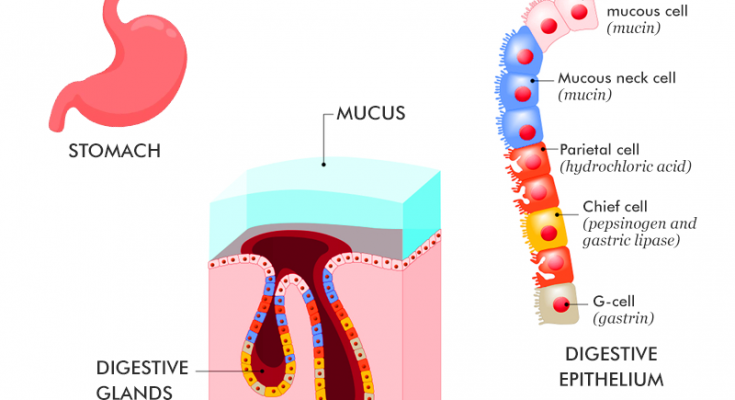The Gastric Glands are specialised structures located in the lining of the stomach that play a crucial role in the digestive process. These glands are responsible for the production and secretion of various substances necessary for the breakdown of food and the absorption of nutrients.
Table of Contents
Definition of Gastric Glands
Gastric Glands are small, tube-like structures located in the lining of the stomach, the inner lining of the stomach. They are made up of different types of cells that work together to produce and release certain substances involved in digestion. The unique composition and arrangement of these glands allows them to perform their vital functions in the digestive process.
Location of the Gastric Glands

The Gastric Glands are mainly present in the mucosa, the innermost layer of the stomach. The mucosa consists of numerous small invaginations, called gastric pits, in which the Gastric Glands are located. These pits are evenly distributed over the mucous membrane of the stomach and enable efficient secretion and release of digestive substances.
The stomach is divided into different regions, each with its own specific arrangement of Gastric Glands. The cardiac region, located near the entrance to the stomach, contains mainly cardiac glands. The fundic region, which makes up most of the stomach, houses fundic glands. The pyloric region, located near the stomach outlet, contains pyloric glands.
Also Check – Digestive Glands – Definition , Types and Functions
Distribution in the gastric mucosa

The Gastric Glands are widely distributed in the gastric mucosa. They are present in large numbers, especially in the fundus region where they are most numerous. The distribution of the Gastric Glands ensures that the secretory functions of the stomach are carried out effectively, regardless of the location of the food within the organ.
The arrangement of the Gastric Glands follows a repetitive pattern along the mucosa. Each pit of the stomach branches into several tubular Gastric Glands that extend deeper into the underlying layers of the stomach. This intricate network of glands ensures that the secretory capacities of the stomach are well distributed and able to absorb the volume and composition of the food consumed.
Also Check – Function of Stomach in Digestive System
Gastric Glands Diagram

Structure of the Gastric Glands
Gastric Glands are specialised structures located in the gastric mucosa, the inner lining of the stomach. They are responsible for the production and release of gastric juice, which helps digest food. The Gastric Glands are made up of different types of cells organised into glandular units that work together to secrete the various components of gastric juice.
Components of the Gastric Glands

Chief Cells
Chief cells, also known as zymogenic cells, are one of the most important cell types found in the Gastric Glands. They secrete an inactive enzyme called pepsinogen. Pepsinogen is then activated by the acidic pH of the stomach and converted into its active form, pepsin. Pepsin plays a crucial role in the digestion of proteins by breaking them down into smaller polypeptides.
Parietal Cells
Parietal cells, also known as oxyntic cells, are another important cell type in the Gastric Glands. They are responsible for the secretion of hydrochloric acid (HCl). HCl creates an acidic environment in the stomach that aids protein digestion, activates pepsinogen to pepsin and kills harmful microorganisms in the food. The parietal cells also secrete intrinsic factor, which is essential for the absorption of vitamin B12 in the small intestine.
Mucous Cells
Mucous cells, also called surface epithelial cells, are specialised cells that secrete mucus. Mucus forms a protective layer that coats the stomach lining and prevents damage from the acidic environment of the stomach. It acts as a physical barrier, preventing direct contact between stomach acid and stomach tissue. Mucus also lubricates food and facilitates its movement in the stomach.
Also Check – What will happen if Mucus is not Secreted by the Gastric Glands
G-cells
G-cells or gastrin-producing cells are specialised endocrine cells found in the Gastric Glands. They secrete the hormone gastrin, which plays a crucial role in regulating gastric secretion. Gastrin stimulates the release of gastric acid from the parietal cells and thus promotes digestion. It also influences the motility of the stomach and helps to mix and propulsion of food.
These various components of the Gastric Glands work together to ensure the secretion of gastric juice, which contains hydrochloric acid, pepsinogen, mucus and other substances. The coordinated interaction of these components is essential for the proper digestion of food in the stomach.The structure and composition of Gastric Glands vary depending on the region of the stomach.
Types of Gastric Glands

Cardiac Glands
Cardiac glands are one of the types of Gastric Glands found in the cardiac region of the stomach, located near the entrance, close to the oesophagus. These glands secrete mucus and a small amount of pepsinogen, an inactive precursor of the enzyme pepsin. The mucus produced by the cardiac glands helps to protect the delicate lining of the oesophagus from the corrosive action of stomach acid and helps to lubricate the food as it is swallowed.
Fundus glands
The fundic glands, also known as oxyntic glands, are the most abundant and widespread Gastric Glands in the stomach. They are mainly located in the fundus region, which makes up the largest part of the stomach. Fundic glands are made up of different types of cells that are responsible for the secretion of various substances involved in digestion.
Parietal Cells
Parietal cells, also known as oxyntic cells, are one of the most important types of cells in the fundic glands. They secrete hydrochloric acid (HCl) into the gastric lumen. HCl plays a crucial role in the digestive process by creating an acidic environment necessary for the activation of pepsinogen to pepsin, as well as helping to break down proteins and destroy ingested bacteria.
Major cells
The principal cells are another important cell type in the pancreas. They secrete pepsinogen, an inactive enzyme precursor. Pepsinogen is later activated into pepsin in the presence of the acidic environment produced by the parietal cells. Pepsin is responsible for breaking down proteins into smaller polypeptides and initiates the digestion of food proteins in the stomach.
Mucosal cells
Mucous cells, also known as surface epithelial cells, are scattered throughout the fundic glands and the gastric pits. They produce and secrete mucus, which forms a protective layer over the stomach lining, preventing damage from stomach acid and acting as a lubricant for food movement.
Pyloric Glands
Pyloric glands are located in the pyloric region of the stomach, which is near the outlet leading to the small intestine. These glands mainly secrete mucus and a hormone called gastrin. The mucus produced by the pyloric glands helps protect the lining of the stomach and facilitates the movement of food into the small intestine. Gastrin, on the other hand, plays a role in regulating gastric secretion and promotes contraction of the stomach muscles to facilitate the movement of partially digested food into the small intestine for further digestion and absorption.
Also Check – Nutrition in Human Being
Secretions of the Gastric Glands
The secretions of the Gastric Glands are-
- Mucus- a thick, slippery substance that lines the stomach lining and protects it from acid and enzymes. It is secreted by surface mucous cells and the mucus neck cells.
- Hydrochloric acid- a strong acid that activates pepsin and kills bacteria. It is secreted by the parietal cells.
- Pepsin- a proteolytic enzyme that digests proteins. It is secreted by chief cells as pepsinogen, which is converted into pepsin by hydrochloric acid.
- Rennin- an enzyme that curdles milk in infants. It is secreted by chief cells.
- Intrinsic factor- a glycoprotein that binds to vitamin B12 and facilitates its absorption in the small intestine. It is secreted by the parietal cells.
- Gastrin- a hormone that stimulates gastric activity and motility. It is secreted by enteroendocrine cells (G cells).
Function of the Gastric Glands
The functions of the Gastric Glands focus primarily on the secretion of gastric juice, which contains various substances that help digest food in the stomach. The main components of gastric juice and their functions include-
Hydrochloric acid (HCl)
HCl is secreted by the parietal cells and has several important functions-
- Activates pepsinogen to pepsin- HCl creates an acidic environment that converts the inactive enzyme pepsinogen, secreted by the parietal cells, into its active form, pepsin. Pepsin is responsible for breaking down proteins into smaller polypeptides during protein digestion.
- Kills bacteria- The strong acidity of HCl helps to eliminate or inhibit the growth of harmful bacteria and microorganisms present in ingested food, thus preventing possible infections.
Also Check- What is the role of Acid in our Stomach?
Pepsin
It is secreted by chief cells as pepsinogen and plays a crucial role in protein digestion
- Activation of pepsinogen- Pepsinogen is converted into active pepsin by the presence of HCl in the stomach. Once activated, pepsin hydrolyses proteins into smaller polypeptides, initiating the process of protein digestion.
Also Check – How are Fats Digested in our Body ? Where does this process take place?
Rennin
Rennin, secreted by chief cells, is primarily involved in the digestion of milk in infants
- It makes the milk coagulable- rennin contributes to the coagulation of milk in infants, facilitating its digestion and absorption.
Mucus
Mucus is secreted by the mucosal cells on the surface and the mucosal cells on the neck and plays a protective role in the stomach
- It coats the stomach lining- Mucus forms a protective layer that coats the inner lining of the stomach and forms a physical barrier between the stomach wall and the acidic gastric juices. It helps prevent damage to the stomach lining caused by the acidic environment and the digestive enzymes contained in the gastric juice.
Intrinsic factor
The intrinsic factor secreted by the parietal cells is essential for the absorption of vitamin B12 in the small intestine
- Facilitates the absorption of vitamin B12- Intrinsic factor binds to vitamin B12, protecting it from degradation by gastric acid. This complex is then recognised and absorbed in the terminal ileum of the small intestine. This ensures the proper absorption of vitamin B12, which is necessary for various cellular processes, including red blood cell production.
Gastrin
Gastrin is secreted by enteroendocrine cells (G cells) and regulates gastric activity and motility
- Stimulates gastric activity- gastrin acts as a hormone that stimulates the secretion of gastric juices, including HCl by parietal cells, and the release of pepsinogen by chief cells. It also stimulates gastric contractions, aiding the mixing and movement of partially digested food in the stomach.
Frequently Asked Important questions on Gastric Glands
What are Gastric Glands?
Answer- Gastric Glands are specialised structures located in the lining of the stomach that play a crucial role in the digestive process.
Where are the Gastric Glands located in the stomach?
Answer- The Gastric Glands are mainly located in the mucosa, the innermost layer of the stomach. They are located in small invaginations, the gastric pits, which are evenly distributed over the mucous membrane of the stomach.
What are the different regions of the stomach and their respective types of Gastric Glands?
Answer- The cardiac region, located near the entrance to the stomach, contains cardiac glands.
The fundic region, which makes up most of the stomach, contains fundic glands.
The pyloric region, near the exit of the stomach, contains pyloric glands.
How are the Gastric Glands distributed in the gastric mucosa?
Answer- The Gastric Glands are widely distributed in the gastric mucosa. They are present in large numbers, especially in the fundus region where they are most numerous. This distribution ensures effective secretion and release of digestive substances, regardless of where food is located in the organ.
What is the structure of the Gastric Glands?
Answer- The Gastric Glands are made up of different types of cells organised into glandular units that work together to secrete gastric juice.
What are the Chief cells and what is their function?
Answer- Chief cells, also called zymogenic cells, secrete the inactive enzyme pepsinogen. Pepsinogen is activated by the acidic pH of the stomach and converted into its active form, pepsin, which helps digest proteins.
What are the parietal cells responsible for?
Answer- Parietal cells, also known as oxyntic cells, secrete hydrochloric acid (HCl), which creates an acidic environment in the stomach for protein digestion. They also secrete an intrinsic factor, which is essential for the absorption of vitamin B12 in the small intestine.
What is the function of the mucosal cells?
Answer- Mucosal cells, also called surface epithelial cells, secrete mucus that forms a protective layer that coats the stomach lining. The mucus prevents damage from the acidic environment, acts as a physical barrier and lubricates food to facilitate its movement around the stomach.
What are the G cells responsible for?
Answer- G-cells or gastrin-producing cells are endocrine cells found in the Gastric Glands. They secrete the hormone gastrin, which regulates gastric secretion. Gastrin stimulates the release of gastric acid from the parietal cells, promotes digestion and influences gastric motility.
What substances are contained in gastric juice?
Answer- Gastric juice contains hydrochloric acid, pepsinogen, mucus and other substances necessary for digestion.
How does the structure and composition of the Gastric Glands differ in the different regions of the stomach?
Answer- The structure and composition of the Gastric Glands varies depending on the region of the stomach. There are specific arrangements of Gastric Glands in different regions, such as cardiac glands in the cardiac region, fundic glands in the fundic region and pyloric glands in the pyloric region.
What is the function of the mucus secreted by the cardiac glands?
Answer- The mucus secreted by the cardiac glands helps to protect the delicate lining of the oesophagus from stomach acid and lubricate the food as it is swallowed.
What is the role of the parietal cells in the fundic glands?
Answer- The parietal cells in the fundic glands secrete hydrochloric acid (HCl) into the gastric lumen, creating an acidic environment necessary for the activation of pepsinogen to pepsin, the breakdown of proteins and the destruction of ingested bacteria.
Which cells secrete pepsinogen in the stomach?
Answer- Chief cells secrete pepsinogen in the stomach.
What is the function of the mucus secreted by the mucosal cells?
Answer- The mucus secreted by the mucosal cells forms a protective layer over the stomach lining that prevents damage from stomach acid and serves as a lubricant for food movement.
Where are the pyloric glands located and what do they secrete?
Answer- The pyloric glands are located in the pyloric region of the stomach, near the outlet that leads to the small intestine. They mainly secrete mucus and the hormone gastrin.
What are the components of gastric juice?
Answer- The components of gastric juice include hydrochloric acid (HCl), pepsin, rennin (in infants), mucus, intrinsic factor and gastrin.
How does hydrochloric acid (HCl) contribute to the digestive process?
HCl activates pepsinogen to pepsin, which is essential for protein digestion. It also helps to kill bacteria in ingested food.
What is the role of the intrinsic factor secreted by the parietal cells?
Answer- Intrinsic factor facilitates the absorption of vitamin B12 in the small intestine, which is necessary for various cellular processes, including red blood cell production.
How does gastrin influence the activity and motility of the stomach?
Answer- Gastrin stimulates the secretion of gastric juices, including HCl and pepsinogen, and gastric contractions, thus assisting the mixing and movement of partially digested food in the stomach.
Tricky Questions on Gastric Glands
How do Gastric Glands in the stomach contribute to nutrient absorption?
Answer- Gastric Glands primarily aid in the breakdown of food through the secretion of gastric juice. While they do not directly participate in nutrient absorption, their secretions, such as pepsinogen and gastric acid, create an optimal environment for digestion. Nutrient absorption mainly occurs in the small intestine.
What is the difference between chief cells and parietal cells in Gastric Glands?
Answer- Chief cells secrete pepsinogen, which is converted to pepsin and aids in protein digestion. Parietal cells, on the other hand, secrete hydrochloric acid (HCl) and intrinsic factor. HCl creates an acidic environment for digestion, while the intrinsic factor helps in the absorption of vitamin B12. Both cell types work together to facilitate the digestion process.
How does the distribution of Gastric Glands ensure efficient digestion?
Answer- The Gastric Glands are evenly distributed throughout the gastric mucosa, allowing for efficient secretion and release of digestive substances. Regardless of the food’s location within the stomach, the glands’ arrangement ensures that the secretory functions are well distributed, capable of absorbing the volume and composition of the food consumed.
Also Check – Lineage and clonal development of gastric glands
What would happen if the mucus secretion by mucous cells is impaired?
Answer- Impaired mucus secretion would result in a reduced protective layer on the stomach lining. This could lead to an increased risk of damage from the acidic environment of the stomach, potentially causing ulcers or irritation to the stomach tissues.
Can the Gastric Glands adapt to changes in dietary habits?
Answer- Yes, the Gastric Glands can adapt to changes in dietary habits. For example, when an individual consumes a protein-rich meal, the Gastric Glands can increase their secretion of pepsinogen and hydrochloric acid to accommodate the increased need for protein digestion.
Are all Gastric Glands the same in structure and function?
Answer- No, the Gastric Glands in different regions of the stomach have variations in structure and function. Cardiac glands, fundic glands, and pyloric glands have distinct arrangements and secrete different substances. This specialisation allows for specific functions based on the region’s location and requirements.
Also Check – Morphogen Signals Shaping the Gastric Glands in Health and Disease
What would happen if there is excessive secretion of gastric acid by parietal cells?
Answer- Excessive secretion of gastric acid can lead to a condition called hyperacidity or acid reflux. This can cause discomfort, heartburn, and damage to the oesophagus over time. In severe cases, it may contribute to the development of gastric ulcers.
How does gastrin influence the mixing and propulsion of food in the stomach?
Answer- Gastrin stimulates the release of gastric acid from parietal cells, which promotes the contraction of the stomach muscles. This contraction helps mix and propel the food, aiding in the mechanical breakdown and further digestion of the food particles.
What is the primary function of the pyloric glands in the stomach?
Answer- The primary function of the pyloric glands is to secrete mucus and the hormone gastrin. (Tricky aspect- Some may mistakenly assume the primary function is digestion or enzyme secretion.)
Which cell type in the Gastric Glands is responsible for secreting pepsinogen?
Answer- Chief cells are responsible for secreting pepsinogen. (Tricky aspect- Some may confuse this with parietal cells, which secrete hydrochloric acid.)
What is the function of rennin in the stomach?
Answer- Rennin is an enzyme secreted by chief cells that curdles milk in infants, facilitating its digestion and absorption. (Tricky aspect- Rennin is not as commonly known as other digestive enzymes like pepsin.)
Which cells in the stomach produce intrinsic factors?
Answer- Parietal cells produce intrinsic factors. (Tricky aspect- Some may think intrinsic factors are produced by mucosal cells.)
What are the main components of gastric juice secreted by the Gastric Glands?
Answer- The main components of gastric juice include hydrochloric acid (HCl), pepsinogen, mucus, rennin (in infants), intrinsic factor, and gastrin. (Tricky aspect- Some may forget to include rennin and intrinsic factor.)
How does gastrin influence gastric secretion and motility?
Answer- Gastrin stimulates the release of gastric acid from parietal cells and promotes gastric contractions, aiding in digestion and movement of food. (Tricky aspect- Some may mistakenly think gastrin inhibits gastric secretions.)


One Comment on “Gastric Glands – Location , Structure, Types, Secretion and Functions”